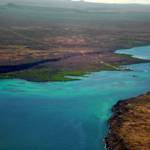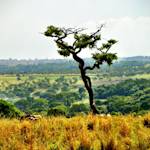Serengeti National Park, the great migration
1951 CE • Northern Tanzania
"The Serengeti is a vast ecosystem in east-central Africa. It spans 12,000 square miles (30,000 square kilometers), according to NASA, giving rise to its name, which is derived from the Maasai language and means "endless plains." This region of Africa is located in north Tanzania and extends to southwestern Kenya. The Serengeti encompasses Serengeti National Park and a number of protected game reserves and conservation areas maintained by the governments of Tanzania and Kenya. The region hosts the largest mammal migration in the world and is a popular destination for African safaris . . . Blue wildebeests, gazelles, zebras and buffalos inhabit the region, along with lions and spotted hyenas . . . Each year the great wildebeest migration begins in December in the Ngorongoro area of the southern Serengeti of Tanzania, which offers rich grasslands for feeding . . . large mammals are not the only ones that make their home in the Serengeti. Gaudy agama lizards and rock hyraxes make themselves comfortable in the numerous granite kopjes, which are formations of huge boulders of sparkling, coarse rock. A full 100 varieties of dung beetle have been recorded, as have 500-plus bird species, ranging from the outsized ostrich to the black eagles that soar effortlessly above the Lobo Hills . . . The Maasai people had been grazing their livestock in the open plains for around 200 years when the first European explorers visited the area . . . Because the hunting of lions made them so scarce, the British decided to make a partial game reserve of 800 acres (3.2 square km) in the area in 1921 and a full one in 1929. These actions became the basis for Serengeti National Park, which was established in 1951."
Kim Ann Zimmermann, "The Serengeti: Plain Facts about National Park & Animals," Live Science, June 23, 2017.
Image: Güldem Üstün via Flickr, Attribution 2.0 Generic (CC BY 2.0)


Learn about Maya Lin’s fifth and final memorial: a multi-platform science based artwork that presents an ecological history of our world - past, present, and future.

Discover ecological histories and stories of former abundance, loss, and recovery on the map of memory.

Learn how we can reduce our emissions and protect and restore species and habitats – around the world.

See how art can help us rethink the problems we face, and give us hope that each one of us can make a difference.

Help make a global memorial something personal and close to home. Share your stories of the natural world.


